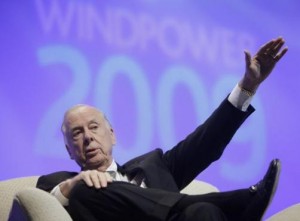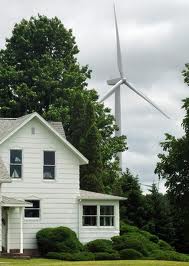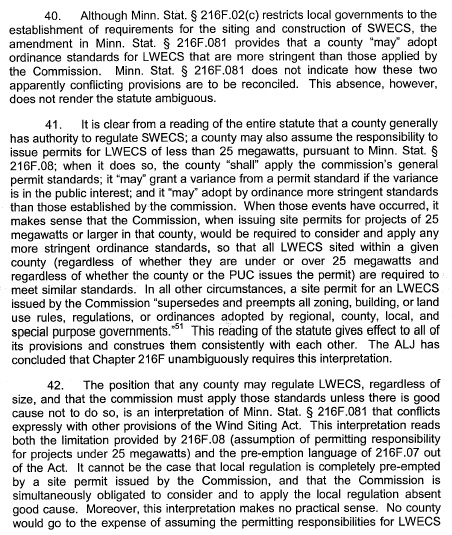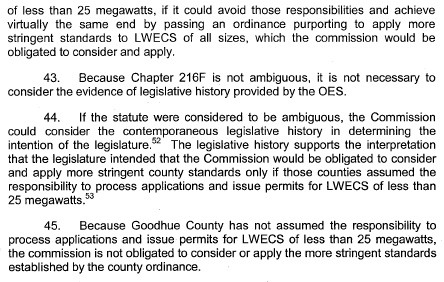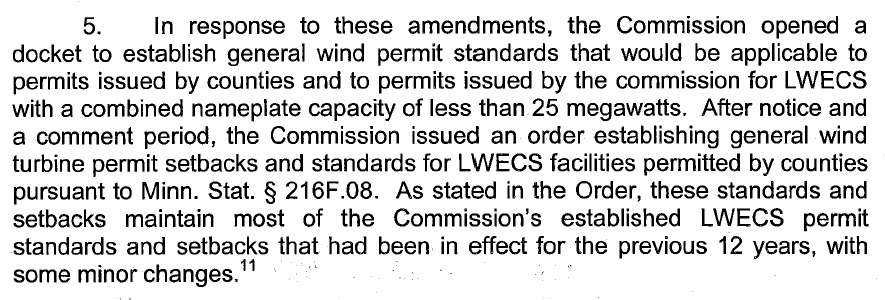AWA Goodhue PUC Order is out!
August 24th, 2011
The T. Boone Pickens wind project in Goodhue County, masquerading as a “C-BED” project now has a formal permit issued by the Public Utilities Commission. It’s LONG, and will take some serious study:
Next? Motion for Reconsideration – probably by ALL parties!
Duluth News Tribune on Excelsior Energy scams
August 24th, 2011
For years and years, I represented mncoalgasplant.com opposing this wretched boondoggle of a pipe-dream of “clean” and “green.”
The project lingers on, on life-support, and pulling the plug is long overdue.
The good news is that the Duluth News Tribune is finally paying attention, and looking into the financial irregularities. Duluth News articles are here, and next will be some responses.
It started with an article in Duluth News Tribune, first in a series, the second below:
Published August 21, 2011, 09:40 AM
Millions in public money spent, but Iron Range power plant still just a dream
By: Peter Passi, Duluth News Tribune
Yet Micheletti said he’s stopped making predictions as to when Excelsior will build its first plant.
How much more pay Micheletti and Jorgensen have received since 2006 has not been publicly disclosed.
Part II of the Duluth News Tribune series on Excelsior Energy:
Published August 22, 2011, 12:30 AM
Iron Range energy project seeks lifeline in more funding, new fuel source
By: Peter Passi, Duluth News Tribune
* EARLIER: Millions in public money spent, but Iron Range power plant still just a dream
Gone are state funds, including:
# $10 million from the Minnesota Renewable Development Fund.
“We’ve got staying power to see our way through this,” he said.
Sen. Tom Bakk, D-Cook, supported Excelsior’s request.
“There’s much less risk from an investor standpoint,” he said.
But Anzelc said Excelsior still lacks one essential: a customer.
“To my knowledge, no on in the power business is supportive of this project,” he said.
Even the revamped natural gas plant plan could be a tough sell, however.
Minnesota Power’s Mullen described what he considers “a flat market” for power generation,
But he’s not counting Excelsior out.
“You have to give them credit for their tenacity,” Mullen said.
Wind projects aren’t benign, to birds, or to humans…
July 25th, 2011
The importance of siting properly — maybe the message is getting through? Just like a nuclear plant, you can’t be putting generators in the ground without a lot of respectful planning and consideration for neighbors, be they the people living next door or the migratory birds making their way through, or in their foraging, roosting and nesting territory.
Eagles are as much an issue here as with the CapX 2020 Brookings transmission line crossing of the Minnesota River, and will be an issue with any of the proposed crossings for the CapX 2020 transmission line across the Mississippi River, which is North America’s major migratory flight path. Eagles in the proximity of transmission lines was the reason (arguably, because the real reason was that they couldn’t use the Myrick Road route, but that’s a whole ‘nother post, see www.nocapx2020.info and search for “Myrick”).
When you’re planning utility infrastructure, and permitting it, you’ve got to have concerns for impacts, but when it’s no
longer the “Environmental Quality Board” handling it, and it’s the Dept. of COMMERCE with their COMMERCE charge, humans and eagles don’t have a chance against the corporate promoters of these projects. It’s time to transfer review back to the Environmental Quality Board and develop standards for siting (do you know there are NO standards for
siting wind projects over 25MW? They just do it on a case by case basis, with no scientific basis whatsoever), and eliminate the Dept. of Commerce and their corporate shills from any oversight of utility projects, unless they want to intervene as a party.
Yesterday there were two articles on this, in the STrib and the LA Times:
Bald eagles could thwart Red Wing wind farm
Wind farms multiply, fueling clashes with nearby residents
Here are the full articles so they’ll be around once archived. First from the STrib:
Bald eagles could thwart Red Wing wind farm
* Article by: JOSEPHINE MARCOTTY , Star Tribune
* Updated: July 25, 2011 – 1:57 AMIn battle against a Red Wing project, citizens turn to a national symbol.
But there is no certainty such a plan will succeed in protecting eagles or other endangered species.
But that’s only if the deaths are discovered.
“If there are 50 birds hit, are they going to tell anyone?” he said. “We hope they would.”
And in the L.A. Times:
Wind farms multiply, fueling clashes with nearby residents
By Tiffany Hsu, Los Angeles Times
Reporting from Tehachapi, Calif.—
Tehachapi activist Terry Warsaw said he’s worried his community will soon be surrounded by turbines.
“They are not benign things,” she said. “We’ve seen turbines go berserk.”
“Monstrous insects,” she calls them. “I look at the propellers for a moment and my head gets dizzy.”
“We are resembling hundreds of towns around the country,” she said.
Some suggest that removing trees to make way for the machines could lead to erosion and flooding.
Exceptions filed to AWA Goodhue ALJ Recommendation
May 16th, 2011
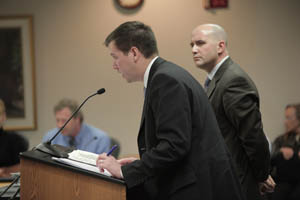 Above, Chuck Burdick with attorney Todd Guerrero arguing at PUC last November.
Above, Chuck Burdick with attorney Todd Guerrero arguing at PUC last November.
Today Exceptions to the Report of the Administrative Law Judge were due in the AWA Goodhue docket.
First, the ALJ’s Recommendation:
And now for the Exceptions:
Belle Creek Township – Exceptions
Coalition for Sensible Siting – Exceptions
ALJ Sheehy Files AWA Goodhue Wind Recommendation
April 30th, 2011
Whew, leave town and look what happens…
What sticks in my craw is this — if the law were unambiguous we would not be here today in this contested case:
And it’s that paragraph 43 and 44 that is particularly obtuse, because from here it looks as though that MOES Affidavit filed, to which GWT objected and about which GWT filed Subpoena Request, which were DENIED:
Goodhue Wind Truth – Subpoena Requests for Bjorklund and Bull
ALJ Sheehy’s Letter to Overland – Denial of Subpoena Requests
Were it unambiguous, we wouldn’t be in this contested case, and she wouldn’t be going through this elaborate dance to get to “it’s unambiguous.”
If it walks like an ambiguous, if talks like an ambiguous, it’s ambiguous…
Oh, and here’s another bizarre part, claiming that there are state standards in existence for 12 years:
Uh-huh… right…
